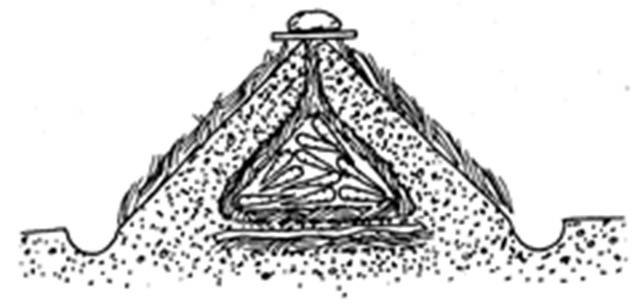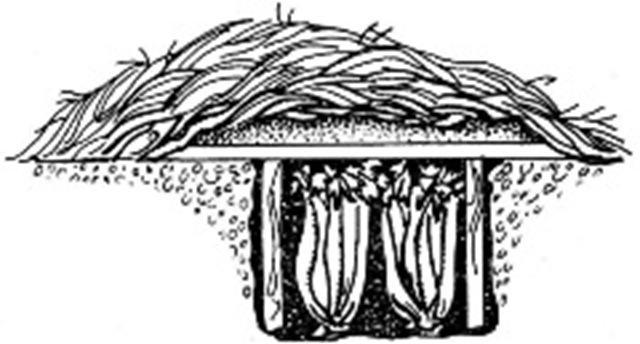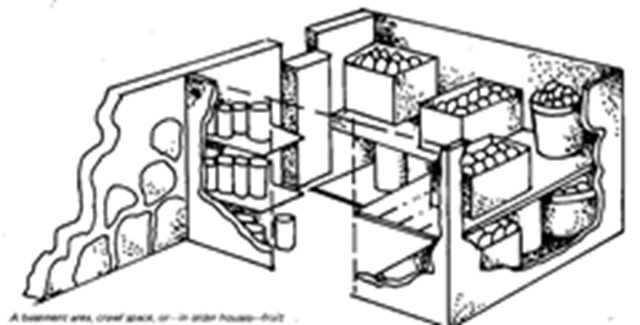Where winters are mild and there isn’t much snow, outside storage is an easy answer to holding large crops. You can store vegetables in well-insulated mounds or barrels, or in little underground lean-tos. Both cold-moist and cool-moist vegetables can be stored in these outdoor locations.
Mound storage
When planning mound storage, first find a spot in your garden where the mound will have good drainage. Dig a shallow, dish-shaped hole six to eight inches deep, and line it with straw or leaves. Spread the straw bed with some metal screening (to keep 6ut burrowing animals), and then stack your vegetables in a cone on the prepared bed. Wrap the individual pieces and separate the layers of food with packing material.
Making a cone or volcano shape, cover the mound with more straw or leaves, then shovel on three or four inches of dirt. Cover all but the top of the cone. Pack the dirt firmly with the back of your shovel. Pile on another thick (six- to eight-inch) layer of straw, but don’t cover the top of the cone — it must be left open for ventilation. Put a piece of board on top of each mound to protect it from the weather. If necessary, weight the board with a stone or a brick to keep it in place. Finally, dig a shallow drainage ditch around the mound.You can store several kinds of vegetables in the same mound, if they’re separated by packing material — that way you can enjoy a bushel of mixed vegetables instead of all carrots or all potatoes. However, several small mounds are more practical than one large mound. Once you’ve opened a mound, it can’t be repacked again—which means you’d have to take out all the vegetables at one time. With several smaller mounds, you can bring manageable portions of vegetables into the house, without having to disturb the whole store. The U.S. Department of Agriculture recommends changing the location of the pits every year to avoid contamination.
Cabbage mound storage
If you want to be able to remove cabbages a few at a time, you can store heads in a mound that’s rectangular rather than volcano-shaped. Prepare a long, narrow, rectangular mound with the same base of straw or leaves, metal screening, and more straw, as directed for mound storage. Then put in the individual heads of cabbage head-down in one layer, more straw, and a final layer of dirt. Dig a small trench along each long side of the mound to drain off water. With this type of mound, you can remove just a few cabbages at a time, because there’s only one layer of heads.

A storage mound in a garden provides safe keeping for your vegetables. A ground-level screen discourages burrowing animals; layers of straw and dirt topped by a board shelter the vegetables inside the cone-shaped mound.

Vegetables like celery, Chinese cabbage, or lettuce store well in frames. To make a frame, stand the vegetables in bundles in a trench about one foot deep. Cover them with a lean-to of boards and mound straw and over the dirt top.

cellar can be closed off to stay cold and moist to make an effective root cellar for your vegetables. Many vegetables can be stored all winter in a well-planned root cellar.
Barrel storage
Choose a well-drained spot in your garden for barrel storage. Dig out a hole deep enough to cradle the barrel on its side — the barrel doesn’t have to be completely buried. Line the hole with straw, and nest the barrel into it. Pack in the vegetables, cover the barrel opening with metal screening or tight-fitting wood covers to keep out rodents, then cover the whole barrel with several insulating layers of straw and dirt. Be sure to mark the location of the barrel mouth, so you can find it easily when you’re ready to dig out the vegetables.
Frame storage
Frame storage is a special method that works best for celery and celerylike vegetables, such as Chinese cabbage and fennel. In this little underground lean-to, you store the celery bunches upright with their roots in the ground. Dig a trench about one foot deep, two feet wide, and as long as needed to hold the celery you’ve grown. Harvest the celery, leaving the roots intact, and stand the bunches up — closely together— in the trench. Water the roots, and
leave the trench open until the celery tops are dry. Build a lean-to over the celery with the boards — set a wide board on edge along one side of the trenched celery, and prop another wide board against this support to make a slanted roof over the bunches of celery. Finally, cover the lean-to with straw and then with dirt.
